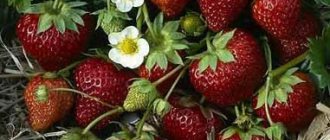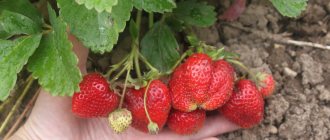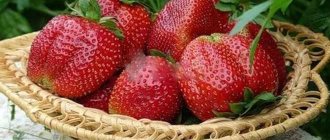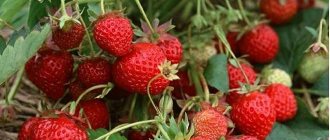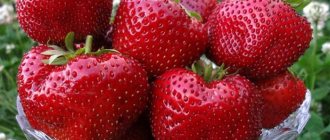Description of strawberry Tago
You can enjoy the fruits of Tago no earlier than the beginning of July. The bushes reach medium height and average foliage. The leaves are colored rich green. Increased formation of antennae promotes rapid reproduction. Thanks to this, the variety can be updated regularly.
The berries, the first to be picked from the bush, have an elongated shape, which makes them look like a cone. Strawberries harvested at the end of the season are characterized by a round shape. They are painted in the characteristic color of strawberries - red.
The weight of the berries reaches 30-60 g. They give off a pleasant strawberry aroma. The juicy pulp has medium density. During consumption, a slight sourness is felt. The cut shows that the inside of the berry is red, which indicates full ripening.
Strawberry variety Fireworks
The strawberry variety Fireworks is one of the domestic varieties with a medium ripening period and a universal harvest purpose.
The originator of this variety, worthy in all respects, is the All-Russian Research Institute of Genetics and Selection of Fruit Plants named after I.V. Michurin. The “Fireworks” variety was included in the State Register of the Russian Federation quite a long time ago and has become most widespread in home gardening in the Central Black Earth region of our country.
Plant characteristics
The leaves are dark green, flat in shape, with a characteristic shine. The flowers are large in size, white, without petal torsion. Peduncles are medium in size, located below the level of the leaves. Productivity is high and constant. Fruiting is very stable.
Description of the berry variety
Fully ripened and ready for picking, the berries have an average weight of 11-13 g, regular shape and a short neck. The surface of the ripe berry is dark red in color, with a pronounced gloss. The berry is recommended for fresh use and is perfect for making jams and preserves.
The pulp of the ripe berry is dark red in color, dense in consistency, and sour-sweet in taste. The average sugar content is just over 7%. The acidity of the pulp does not exceed 1.2%. The amount of vitamin C is 77 mg/%. According to the tasting results, the berries scored 4.8 points. Average yields do not exceed 160−161 c/ha. The variety is characterized by resistance to fungal diseases and has relatively high winter hardiness.
Planting and growing
It is recommended to plant Fireworks strawberries in August-September or early spring, preferably in cloudy weather. The ridges must be located in areas that are well protected from gusty winds. It is advisable that in winter the ridges be covered with a layer of snow by 25–30 cm. Only the largest and most healthy rosettes with a well-developed root system should be planted.
The area should not have any shadows
You should pay attention to the soil moisture indicators on the ridges allocated for growing this berry crop. Garden strawberries of the “Fireworks” variety can be grown from strawberry tendrils or by dividing the rhizomes of this berry crop
Almost any type of fertile soil, except peat soils, is well suited for planting strawberry seedlings. In order to obtain the best possible results, it is recommended to add humus and wood ash during deep digging of the soil.
To get a high yield of high-quality berries when growing garden crops in open ground, it is necessary to carry out regular watering and prevent both the soil from drying out and being too waterlogged. Strawberries are fertilized at least three times per season and are always accompanied by abundant irrigation measures. Caring for berry plantations includes weeding, loosening and timely and correct preventive spraying of strawberry bushes.
Watering and fertilizing strawberries (video)
Berry plantings almost never get sick and winter very well in many regions without the use of shelter. The berry bushes are quite large, but not gigantic in size, and form mustaches, which greatly facilitates the independent propagation of the berry crop without the cost of purchasing planting material. High consumer ratings and positive reviews from gardeners allow us to recommend “Firework” as a promising variety for growing in garden plots and household plots.
Main advantages and disadvantages
Gardeners love Tago strawberries because of their many benefits. The variety has the following positive qualities:
- Characterized by high productivity.
- Suitable for growing in regions with cold climates. Therefore, it is valued for its winter hardiness.
- Rarely affected by spider mites, bacterial and fungal diseases.
- Berries are not damaged during transportation over long distances.
- It has an excellent presentation - shiny surface, rich berry color, delicate aroma and strawberry taste.
- A universal grade for use.
Cons of Tago:
- Susceptibility to spotting.
- Late ripening.
The late ripening period, on the one hand, can be considered an advantage. When the fruiting of early varieties ends, late berries begin to ripen. Thus, strawberries are enjoyed throughout the summer.
There are very few disadvantages, and compared to the advantages they seem insignificant.
What is a strawberry-strawberry hybrid: history of appearance
The hybrid was bred back in the 70s of the last century, that is, zemklunik is not the brainchild of modern selection. The research was carried out by the famous biologist N.K. Smolyaninova, who crossed representatives of the Rose family - strawberries (Fragaria moschata) and large-fruited garden strawberries (Fragaria ananassa). The strawberry varieties Kaiser Seedling and the strawberry Milanskiy were taken as parent forms.
The resulting hybrid form produced large berries with a wonderful aroma. The “minus” is the high sterility of the flower stalks, which is why the setting indicators, unlike garden strawberries (Victoria), were weak.
Later T.S. worked on strawberry-strawberry hybrids (ZKG)
Kantor is a well-known geneticist breeder who paid attention specifically to crop yield. The result is the breeding of a hybrid with a high berry set, which received the name “dredger” when filing a patent.
Subtleties of cultivation
Before planting strawberries, it is worth studying the requirements for timing and soil.
Time to plant strawberries
The standard dates are considered to be early spring and late autumn. In the latter case, the period lasts 3 weeks. Starts at the end of August and continues until mid-September. But, according to gardeners, Tago, like other varieties, can be grown at any time during the growing season.
See also
Description and characteristics of the Kimberly strawberry variety, cultivation and propagationRead
Planting in autumn is more recommended for the southern regions. Strawberry seedlings have time to take root before the onset of winter. If the growing area has a cold climate, spring planting is carried out. In this way, the planted seedlings will safely survive long winters.
Preparation of planting material and site for planting
There are no special preparatory manipulations before disembarkation. Young plants are used as they will take root faster. Damaged and large seedlings are excluded.
There are also no special requirements for the location of the variety on the site. The place must be on the sunny side. In other words, it is very good when Tago seedlings are exposed to direct sunlight most of the day. Otherwise, the ripening of the berries will be delayed.
Constantly keeping Tago in the shade affects the taste of the berries and not for the better. They become sour and also become smaller in size.
Suitable soil is black soil mixed with peat.
Disembarkation process
When planting a crop, the gardener is guided by only one thing - convenience. Tago allows you to independently select a scheme taking into account the land plot. In this case, the distance between the bushes should not be less than 30 cm.
The holes are dug to a depth of about 25 cm. After planting, the strawberries are watered. Saturating the soil increases the chances of taking root and growing. If desired, the soil should be mulched immediately after planting.
Characteristics of the variety
Review of Tago strawberries, description of the variety, photos, reviews, let's start with the main characteristics. According to the ripening period of berries, strawberries are considered medium-late or even late. The bushes grow compact. The foliage is large with a light green leaf blade. The mature bush is dense. Strawberries of the Tago variety winter well, which emphasizes their dignity.
The berries begin to ripen in early July. A distinctive characteristic of Tago garden strawberries is the different shape of the fruits of the first and subsequent tiers of the harvest. The first strawberry resembles a tree bud. The shape of strawberries from subsequent tiers of the harvest is closer to a cone with a truncated top. The pulp becomes bright red when ripe. When the fruit is fully ripe, the skin darkens. The berries are large, dense, and can be transported for a long time. According to its intended purpose, the Tago strawberry variety is recommended for making jam and compote.
Important! The Tago variety is characterized by intensive mustache formation.
Tago strawberries have no special requirements for the location and composition of the soil. However, gardeners noticed the fact that in sunny areas the berries grow larger and sweeter. It is optimal to place the garden bed in an open area. The best soil for Tago strawberries is considered to be black soil with peat additives. It is advisable to mulch the soil in the garden with straw. In addition to preserving moisture, mulch protects the berries from contamination. Subject to the conditions of agricultural technology, the Tago strawberry variety is rarely affected by fungal diseases.
The video provides an overview of garden strawberry varieties:
Rules for caring for strawberries
The plant is not picky and requires a minimum of care procedures. The main thing is that they are regular. Do not forget about watering, removing weeds and replanting.
Irrigation scheme
The soil becomes saturated with moisture as the top layer dries. In prolonged dry weather, the procedure is repeated three times a day. Tago responds positively to sprinkling. At the moment the flowers appear, the strawberries are watered at the root.
The need for watering is determined in another way. Holes 30 cm deep are dug in strawberry beds. Moreover, this is done in different places throughout the site.
Then they examine the soil taken from the very bottom of the hole. If the soil crumbles in your hands when kneading, the strawberries need watering. In cloudy weather and cold summers, the amount of irrigation is reduced to 1 time per week. When pouring berries, Tago is watered every 5 days.
Fertilizer application
To maintain growth and fruiting, Tago is fed three times a season. The first application of fertilizers is carried out after the snow melts. Fertilizers are a complex of useful substances that are applied in liquid form.
The second feeding should be root feeding and carried out during flowering. Strawberries are watered with mullein, previously filled with water. For 1 part water you will need 6 parts mullein. At the end, the bushes are sprinkled with wood ash.
See also
Planting, growing and caring for strawberries in open ground in Siberia and the best varietiesRead
The third application of fertilizers is carried out after the end of fruiting. Superphosphate is used. 50 g of the substance is dissolved in 10 liters of water, and the resulting liquid is watered on the bushes.
Mulching and loosening the soil
Mulch is a special layer that protects the soil from the active growth of weeds. Thanks to the coating, moisture does not evaporate from the soil so quickly. Mulching makes caring for strawberry plantings easier. Good mulches include peat, sawdust and straw.
The soil on which strawberries grow needs regular loosening. The procedure is carried out after watering when the soil dries.
Removing the crust on the surface is necessary, as it does not allow the soil to breathe.
Preparing for winter
Preparations begin in the fall. The bushes are carefully prepared before winter. Dry foliage, damaged parts and bad stems are removed.
If the growing region experiences low temperatures, long winters and high rainfall, the crop needs reliable protection. The area with Tago is sheltering. This could be a layer of mulch or other devices.
Agrofibre protects strawberries from the effects of severe frosts in snowless winters. The plant may die at the beginning of winter, since the snow does not have time to fall and protect the plantings from frost. In this case, peat, sawdust or straw will help well. Spruce branches are also suitable as cover for strawberry plantings.
Strawberry planting time
Continuing the review of Tago strawberries, description of the variety, photos, reviews, it’s time to talk about planting the crop. Gardeners claim that strawberries can be planted in the garden at any time during the growing season. However, the best dates are traditionally considered to be early spring, as well as the end of August - mid-September.
Autumn planting of strawberries is beneficial in the southern regions. From the end of August to the beginning of winter, a strawberry seedling of the Tago variety will have time to take root. For cold regions with long winters, spring planting is preferable.
Important! Tago garden strawberries do not grow well in areas where nightshades, cabbage, and cucumbers were planted last season. Strawberries and raspberries are not friends.
Strawberries grow on any soil, but do not tolerate swampy and sandy areas. Loose, slightly acidic soil with good breathability is optimal. If water stagnates in the area, the strawberry roots will begin to rot. The maximum occurrence of groundwater is allowed at a depth of 70 cm.
For spring planting of the Tago strawberry variety, the site is prepared in the fall. The soil is dug up to a depth of 30 cm. Weed rhizomes are removed from the soil, while adding organic matter. About half a bucket of manure, peat, humus or compost is scattered onto 1 m2 of beds. In the spring, just before planting strawberry seedlings of the Tago variety, an additional similar amount of wood ash, 40 g of superphosphate and 20 g of potassium are added.
Advice! Mineral fertilizers can be abandoned on fertile lands.
Tago garden strawberries are planted in rows at a distance of 30 cm from each other. The row spacing is made up to 70 cm wide so that the mustache has room for engraftment. Holes are punched with a hoe to a depth of 25 cm and a diameter of up to 20 cm. The seedling is carefully sprinkled with loose soil so as not to damage the root system and tamped lightly by hand. About 0.5 liters of warm water is poured into the hole.
When filling the root system of strawberries, it is important not to bury the heart. The seedling is immersed in the soil up to the root collar. If you dig deeper, the roots will rot. A fine sprinkling of soil threatens to quickly dry out the strawberry root system under the sun.
After planting the Tago strawberry seedlings, the row spacing is loosened with a hoe. As the soil dries, the plantings are watered. Until complete engraftment, the bushes are shaded during the day from the scorching rays of the sun.
If autumn is chosen for planting Tago strawberry seedlings, then the bed is prepared in three weeks. Organic and mineral fertilizers are applied simultaneously while digging the soil. The process of planting seedlings is no different from the actions carried out in the spring. However, the soil should be covered with straw so that early frosts do not prevent the strawberries from taking root.
Diseases and pests of garden strawberries
Tago received a strong immune system, but it is still not easy to protect herself from a number of diseases. The sources of diseases are insects, fungi, and various microorganisms. By parasitizing the stems and foliage, they drink all the juices, causing the plant to become weak. Therefore, it is more difficult for the immune system to resist diseases.
To eliminate the possibility of developing various diseases, strawberries are treated with various drugs. Treatment products are purchased in specialized stores or prepared independently. The only condition that a person must observe when treating plantings is that treatment is not carried out during the flowering period of the crop .
Placing strawberries in the garden, in the room and on the balcony
Strawberries grow best on loose, permeable sandy loams and light loams with a slightly acidic reaction. You can plant in spring or late summer, when the heat subsides. The planting distance is 20–30 centimeters between plants.
The area for strawberries is dug up in advance using a spade, freeing the rhizomes of perennial weeds. On poor soils, add 2-3 buckets of humus per square meter for digging; on fertile soils, 1 bucket is enough.
In heavy clays and waterlogged areas, strawberries grow better on raised ridges filled with soil suitable for them. In winter, they should be covered with a sufficient layer of snow for the plants to reliably overwinter, so you should not make beds higher than 15 centimeters.
In heavy clays and waterlogged areas, strawberries grow better on raised ridges
In warmer countries, all kinds of pyramids and shelves for growing strawberries are very popular. Such designs save space and look original. However, in hot weather they have to be watered constantly. For most of Russia, this arrangement is suitable only in a collapsible or portable version.
Latest posts 9 reasons why cucumber ovaries turned yellow Why tomatoes dropped flowers in July and did not produce ovaries How to pamper your garden with fertilizers from banana skins
Pyramids and shelves for strawberries are very popular in countries with warm winters
Remontant strawberries in the room
Ruyana's remontant strawberry can grow successfully and even bear fruit indoors. For planting, use small pots or boxes 10–15 centimeters deep, with obligatory drainage holes in the bottom. They are filled with ready-made purchased soil mixture for indoor plants, which has a slightly acidic reaction. Water moderately and periodically feed with liquid fertilizer for houseplants according to the instructions on the package. In the winter season, additional lighting is very desirable, as when growing seedlings. If strawberries bloom, artificial pollination is necessary for the formation of berries: pollen is transferred from flower to flower with a soft brush. In the summer, it is better to expose indoor strawberries to fresh air - on the balcony or in the garden.
Remontant strawberry Ruyana can grow in small containers in the room and on the balcony
Breeding methods
For breeding, use one of the proposed methods:
- seeds;
- dividing the bush;
- antennae.
The second and third methods are popular. The first is used in rare cases. Only professional gardeners or amateurs who want to understand what the method is, decide to grow strawberries with seeds.
A sprout obtained by one of the methods is planted according to the standard scheme. Tago is transplanted to a new place every 4-5 years. Strawberries no longer grow on the site, which is confirmed by appearance and yield.
Brief description of the berry
Strawberries, according to gardeners, are distinguished by powerful, spreading bushes. If there is enough space, they can reach a height of 0.5 meters and grow up to 60 cm in width. These characteristics are several times larger than the generally accepted standard sizes of berries. The foliage of the Tsunaki strawberry variety is quite large, and the flower stalks are powerful. Thanks to the leaf cover, strawberry fruits are reliably protected from direct sunlight. And thanks to the powerful peduncles, the berries do not touch the ground during ripening, which facilitates the entire picking process.
Strawberry fruits have a non-standard uneven shape, slightly flattened. The color varies from bright red to dark burgundy during the period of full technical maturity. The Tsunaki variety is considered one of the largest varieties in terms of berry size. With proper care, you can harvest up to 2-3 kilograms of harvest from one strawberry bush.
The Tsunaki strawberry variety is a medium-late type of strawberry in terms of ripening speed. Strawberries are harvested only once during the summer season, but they are of good quality. The first strawberry fruits can reach a weight of 150 grams. During the summer, some gardeners note the presence of smaller fruits.


